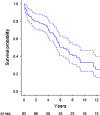Long-Term Outcomes After Open Repair for Ruptured Abdominal Aortic Aneurysm
- PMID: 32152740
- PMCID: PMC7223706
- DOI: 10.1007/s00268-020-05457-7
Long-Term Outcomes After Open Repair for Ruptured Abdominal Aortic Aneurysm
Abstract
Background: Early mortality in ruptured abdominal aneurysm (rAAA) is high, but data on long-term outcome are scarce. The aim of this study was to investigate the long-term outcome in survivors after open surgery for rAAA in well-defined population.
Methods: This is a population-based, observational long-term follow-up (beyond 30-day mortality) study of patients surgically treated for rAAA from 2000 through 2014. Long-term survival was analysed using Kaplan-Meier estimates and compared to the general population by analyses of relative survival.
Results: Out of 178 patients operated for rAAA, 95 patients (55%) either died in the perioperative period, were referred from other hospitals or were lost to follow-up (two patients). Altogether 83 patients were eligible for long-term outcomes: 72 men and 11 women. Estimated median crude survival time was 6.5 years [95% confidence interval (CI) 4.8-8.2]. Men had a median survival of 7.3 years (95% CI 5.1-9.4) versus 5.4 years in females (95% CI 3.5-7.3) (P = 0.082). Reinterventions during follow-up occurred in 31 (37%). Relative survival demonstrated a slightly higher risk of death in the rAAA population compared to the general age- and gender-matched population. Age, but not comorbidities, had a significant influence on long-term survival.
Conclusion: For survivors beyond 30 days after surgery for rAAA, long-term survival compares well to that of an age- and sex-matched population. A high frequency of cardiovascular comorbidities did not seem to affect long-term survival.
Figures



References
Publication types
MeSH terms
LinkOut - more resources
Full Text Sources

